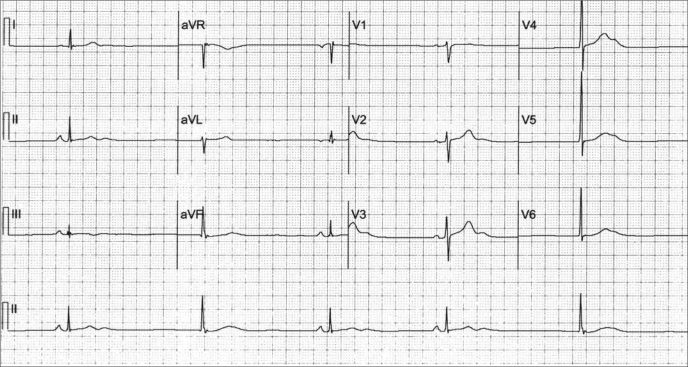A 49-year-old man complained of worsening headaches after using crack cocaine a week earlier. He had a slow heart rate (32 beats per minute) and high blood pressure (174/90 mm Hg), and an electrocardiogram recorded on admission showed sinus bradycardia with junctional escape complexes (Figure).
Figure.
Electrocardiogram recorded on admission shows sinus bradycardia with two junctional escape complexes that have slightly aberrant ventricular conduction. U waves are prominent, consistent with the bradycardia and the patient's low serum potassium of 3.4 mEq/L.
The patient was confused but responsive; his Glasgow coma scale was E3, V4, M6, for a total of 13. A computed tomogram of the head without contrast material showed a left frontoparietotemporal subdural fluid collection 2.3 cm thick and a 1.5 cm left-to-right midline shift. A subacute subdural hematoma was evacuated through burr holes, and the patient was able to leave the hospital.
As recognized by Cushing over a century ago, a slow heart rate and high blood pressure can be signs of increased intracranial pressure, which in its most severe form may be accompanied by a slow respiratory rate and followed by death (1, 2). Subsequent experimental studies have shown that the triad of high blood pressure, slow heart rate, and slow respirations described by Cushing, and also known as Cushing's reflex, response, or phenomenon, often begins with hypertension and tachycardia, with the tachycardia being replaced by bradycardia by the time the patient presents (3–5). The pathophysiological cascade begins with an increase in intracranial pressure that diminishes brain-stem perfusion. This in turn activates the sympathetic nervous system, resulting in elevated blood pressure and tachycardia. The systemic hypertension acts on the carotid baroreceptors and the heart rate reflexly slows, resulting in bradycardia with high blood pressure, which may be acute, subacute, as in this patient, or even chronic depending on the timing of the onset and relief of the increased intracranial pressure (3–5).
References
- 1.Cushing H. Concerning a definite regulatory mechanism of the vasomotor centre which controls blood pressure during cerebral compression. Bull Johns Hopkins Hosp. 1901;12:290–292. [Google Scholar]
- 2.Cushing H. The blood pressure reaction of acute cerebral compression, illustrated by cases of intracranial hemorrhage. Am J Med Sci. 1903;125:1017–1044. [Google Scholar]
- 3.Heymans C. The control of heart rate consequent to changes in the cephalic blood pressure and in the intracranial pressure. Am J Physiol. 1928;85:498–505. [Google Scholar]
- 4.Kalmar AF, Van Aken J, Caemaert J, Mortier EP, Struys MM. Value of Cushing reflex as warning sign for brain ischaemia during neuroendoscopy. Br J Anaesth. 2005;94(6):791–799. doi: 10.1093/bja/aei121. [DOI] [PubMed] [Google Scholar]
- 5.Wan WH, Ang BT, Wang E. The Cushing response: a case for a review of its role as a physiological reflex. J Clin Neurosci. 2008;15(3):223–228. doi: 10.1016/j.jocn.2007.05.025. [DOI] [PubMed] [Google Scholar]



